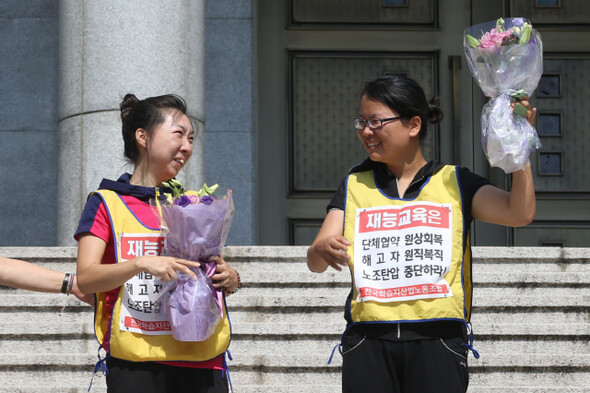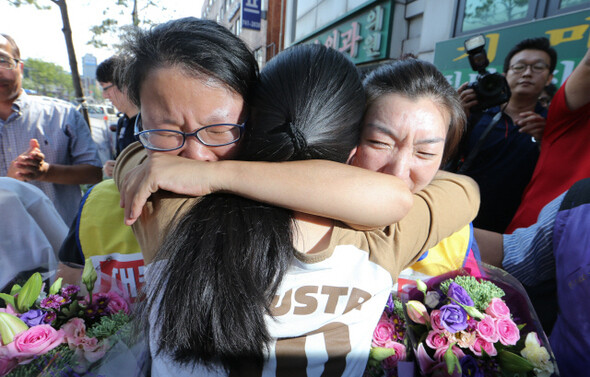hankyoreh
Links to other country sites 다른 나라 사이트 링크
Temp tutors win world’s longest labor struggle

By Jeon Jong-hwi and Park Seung-heon, staff reporters
The “world’s longest-running protest” came to an end on Aug. 26 when two members of the JEI chapter of the Korean Tutors’ and Education Laborers’ Union (KTELU) came down from the bell tower of Seoul’s Hyehwa Cathedral, where they had been perched for 202 days.
In total, it took 2,076 days for acting chapter head Oh Soo-young, 39, and union member Yeo Min-hee, 40, to return to work with reinstatements and a restoration of their collective agreement. The two tutors were laid off from their positions as tutors in December 2007.
Oh and Yeo headed through the iron gate on the third floor, which connects to the 27m-high bell tower, and walked down a flight of 52 steps before touching the ground. On their feet were white sneakers they had received as a present to mark a “new beginning.”
“Like we just got off a roller coaster,” they said when asked about their feelings on coming down. After spending so long in the bell tower looking at the sky, it was a struggle just to walk along the long path. Coming out of the cathedral, they had to cross at a stoplight. It had been so long that they said they felt dizzy walking the less than 300 meters to the front of the JEI offices.
It wasn’t just the walking that made them feel dizzy, but the thought of going back to work as JEI teachers rather than remaining layoff victims.
“I was talking to the brother of late union member Lee Ji-hyun, and he said how grateful he was I was fighting on his sister’s behalf, but I was even more grateful,” said Yeo. “I promised him I was going to get our name back as JEI tutors. I’m happy I was able to keep that promise.”
The JEI workers’ win is a meaningful victory. Working by themselves, workers regained a collective agreement that had been dissolved after failing to win union recognition. The battle began in Dec. 2007 with a dispute with JEI management over transaction fees for tutors, before escalating in late October the following year when the company announced it was unilaterally dissolving the agreement. Now, nearly six years later, the union’s key demands have finally been accepted.
Also notable is the fact that the long-running struggle was fought by so-called “specially employed workers” whose legal status as workers is not clearly recognized. Workers who fall into this category - including “study sheet tutors,” golf caddies, truck drivers, substitute drivers (late night driving service for people who have been drinking), and nurses - are viewed by the law as independent contractors who fall outside the scope of labor law protections, even when their working conditions are similar to a laborer’s. While it only applies to one company, the agreement between JEI and its workers is meaningful as a recognition of tutors’ status as workers.
“It’s been a big problem in South Korea - the employers of specially employed workers don’t assume the responsibilities of employers,” said Lee Nam-sin, director of WorkingVoice, a center for temporary and irregular workers. “So this JEI agreement is something of a turning point. It’s a case where a small set of people made a big sacrifice carrying the cross.”
In the early 2000s, the JEI chapter of KTELU had around 3,800 members. Over the course of the struggle, that number dropped to eleven.
Labor-management agreements at other workplaces after long-term battles have usually had grace periods, but the JEI agreement goes into effect immediately. In the cases of Kiryung Electronics, which had the next longest battle at 1,895 days, and Donghee Auto, which handles all outsourced production for the Kia Morning, the company agreed to follow the agreement after a period of six to eighteen months.
But many in the labor community view the JEI deal as the start of a new struggle rather than the end of an old one. In addition to rebuilding the union, there is still the task of signing a new agreement with the company by the end of the year. At the signing ceremony on the afternoon of Aug. 26, JEI said it planned to “leave behind its reputation as a workplace with long-term labor conflicts and usher in a new, advanced chapter in labor-management relations that are forward-oriented and based in cooperation and mutual benefits.”
Many are now saying that politicians need to honor the spirit of the agreement by amending the Labor Standards Act and the Trade Union and Labor Relations Adjustment Act to recognize the status of special employment workers like the JEI tutors. The argument is that it would only be a source of waste and social conflict for other such workers - an estimated 2.5 million in total - to each fight the same kind of arduous battle as the JEI workers did to have their worker status recognized.
Indeed, the Korean Confederation of Trade Union made calls for a legislative solution in a statement the same day.
“The social costs incurred when employers refuse to recognize unions are unimaginable, and the root causes are employers and a government that do not wish to the grant the workers the rights and recognition they deserve,” it said.
Oh and Yeo spoke casually after the press conference. “I’d like to go home now and wash up. And I’d really like a cold beer,” said one.
But their voices suddenly took on an emphatic tone.
“People need to pay more attention to workers like us in the future. We shouldn’t have to go up in towers to stay alive, because we want to live.”

Please direct questions or comments to [english@hani.co.kr]

Editorial・opinion
![[Column] Season 2 of special prosecutor probe may be coming to Korea soon [Column] Season 2 of special prosecutor probe may be coming to Korea soon](https://flexible.img.hani.co.kr/flexible/normal/500/300/imgdb/original/2024/0426/3317141030699447.jpg) [Column] Season 2 of special prosecutor probe may be coming to Korea soon
[Column] Season 2 of special prosecutor probe may be coming to Korea soon![[Column] Park Geun-hye déjà vu in Yoon Suk-yeol [Column] Park Geun-hye déjà vu in Yoon Suk-yeol](https://flexible.img.hani.co.kr/flexible/normal/500/300/imgdb/original/2024/0424/651713945113788.jpg) [Column] Park Geun-hye déjà vu in Yoon Suk-yeol
[Column] Park Geun-hye déjà vu in Yoon Suk-yeol- [Editorial] New weight of N. Korea’s nuclear threats makes dialogue all the more urgent
- [Guest essay] The real reason Korea’s new right wants to dub Rhee a founding father
- [Column] ‘Choson’: Is it time we start referring to N. Korea in its own terms?
- [Editorial] Japan’s rewriting of history with Korea has gone too far
- [Column] The president’s questionable capacity for dialogue
- [Column] Are chaebol firms just pizza pies for families to divvy up as they please?
- [Column] Has Korea, too, crossed the Rubicon on China?
- [Correspondent’s column] In Japan’s alliance with US, echoes of its past alliances with UK
Most viewed articles
- 1‘We must say no’: Seoul defense chief on Korean, USFK involvement in hypothetical Taiwan crisis
- 2[Column] Season 2 of special prosecutor probe may be coming to Korea soon
- 3N. Korean delegation’s trip to Iran shows how Pyongyang is leveraging ties with Moscow
- 4Amnesty notes ‘erosion’ of freedom of expression in Korea in annual human rights report
- 5Korea sees more deaths than births for 52nd consecutive month in February
- 6[Reportage] On US campuses, student risk arrest as they call for divestment from Israel
- 7[Editorial] New weight of N. Korea’s nuclear threats makes dialogue all the more urgent
- 8‘Weddingflation’ breaks the bank for Korean couples-to-be
- 9Division commander ordered troops to enter raging flood waters before Marine died, survivor says
- 10[Editorial] Korea’s surprise Q1 growth requires objective assessment, not blind fanfare